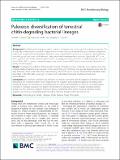| dc.contributor.author | Gruen, Danielle Sarah | |
| dc.contributor.author | Wolfe, Joanna Michelle | |
| dc.contributor.author | Fournier, Gregory P. | |
| dc.date.accessioned | 2019-02-12T21:33:04Z | |
| dc.date.available | 2019-02-12T21:33:04Z | |
| dc.date.issued | 2019-01 | |
| dc.date.submitted | 2018-10 | |
| dc.identifier.issn | 1471-2148 | |
| dc.identifier.uri | http://hdl.handle.net/1721.1/120349 | |
| dc.description.abstract | Background
Establishing the divergence times of groups of organisms is a major goal of evolutionary biology. This is especially challenging for microbial lineages due to the near-absence of preserved physical evidence (diagnostic body fossils or geochemical biomarkers). Horizontal gene transfer (HGT) can serve as a temporal scaffold between microbial groups and other fossil-calibrated clades, potentially improving these estimates. Specifically, HGT to or from organisms with fossil-calibrated age estimates can propagate these constraints to additional groups that lack fossils. While HGT is common between lineages, only a small subset of HGT events are potentially informative for dating microbial groups.
Results
Constrained by published fossil-calibrated studies of fungal evolution, molecular clock analyses show that multiple clades of Bacteria likely acquired chitinase homologs via HGT during the very late Neoproterozoic into the early Paleozoic. These results also show that, following these HGT events, recipient terrestrial bacterial clades likely diversified ~ 300–500 million years ago, consistent with established timescales of arthropod and plant terrestrialization.
Conclusions
We conclude that these age estimates are broadly consistent with the dispersal of chitinase genes throughout the microbial world in direct response to the evolution and ecological expansion of detrital-chitin producing groups. The convergence of multiple lines of evidence demonstrates the utility of HGT-based dating methods in microbial evolution. The pattern of inheritance of chitinase genes in multiple terrestrial bacterial lineages via HGT processes suggests that these genes, and possibly other genes encoding substrate-specific enzymes, can serve as a “standard candle” for dating microbial lineages across the Tree of Life. Keywords: Horizontal gene transfer; Chitinase; Chitin; Bacteria; Fungi; Arthropods | en_US |
| dc.publisher | BioMed Central | en_US |
| dc.relation.isversionof | https://doi.org/10.1186/s12862-019-1357-8 | en_US |
| dc.rights | Creative Commons Attribution | en_US |
| dc.rights.uri | https://creativecommons.org/licenses/by/4.0/ | en_US |
| dc.source | BioMed Central | en_US |
| dc.title | Paleozoic diversification of terrestrial chitin-degrading bacterial lineages | en_US |
| dc.type | Article | en_US |
| dc.identifier.citation | Gruen, Danielle S. et al. "Paleozoic diversification of terrestrial chitin-degrading bacterial lineages." BMC Evolutionary Biology 19 (January 2019): 34 © 2019 The Author(s) | en_US |
| dc.contributor.department | Massachusetts Institute of Technology. Department of Earth, Atmospheric, and Planetary Sciences | en_US |
| dc.contributor.department | Woods Hole Oceanographic Institution | en_US |
| dc.contributor.mitauthor | Gruen, Danielle Sarah | |
| dc.contributor.mitauthor | Wolfe, Joanna Michelle | |
| dc.contributor.mitauthor | Fournier, Gregory P. | |
| dc.relation.journal | BMC Evolutionary Biology | en_US |
| dc.eprint.version | Final published version | en_US |
| dc.type.uri | http://purl.org/eprint/type/JournalArticle | en_US |
| eprint.status | http://purl.org/eprint/status/PeerReviewed | en_US |
| dc.date.updated | 2019-02-03T04:17:30Z | |
| dc.language.rfc3066 | en | |
| dc.rights.holder | The Author(s). | |
| dspace.orderedauthors | Gruen, Danielle S.; Wolfe, Joanna M.; Fournier, Gregory P. | en_US |
| dspace.embargo.terms | N | en_US |
| dc.identifier.orcid | https://orcid.org/0000-0003-1019-4390 | |
| dc.identifier.orcid | https://orcid.org/0000-0002-2941-2514 | |
| dc.identifier.orcid | https://orcid.org/0000-0003-1605-5455 | |
| mit.license | PUBLISHER_CC | en_US |
